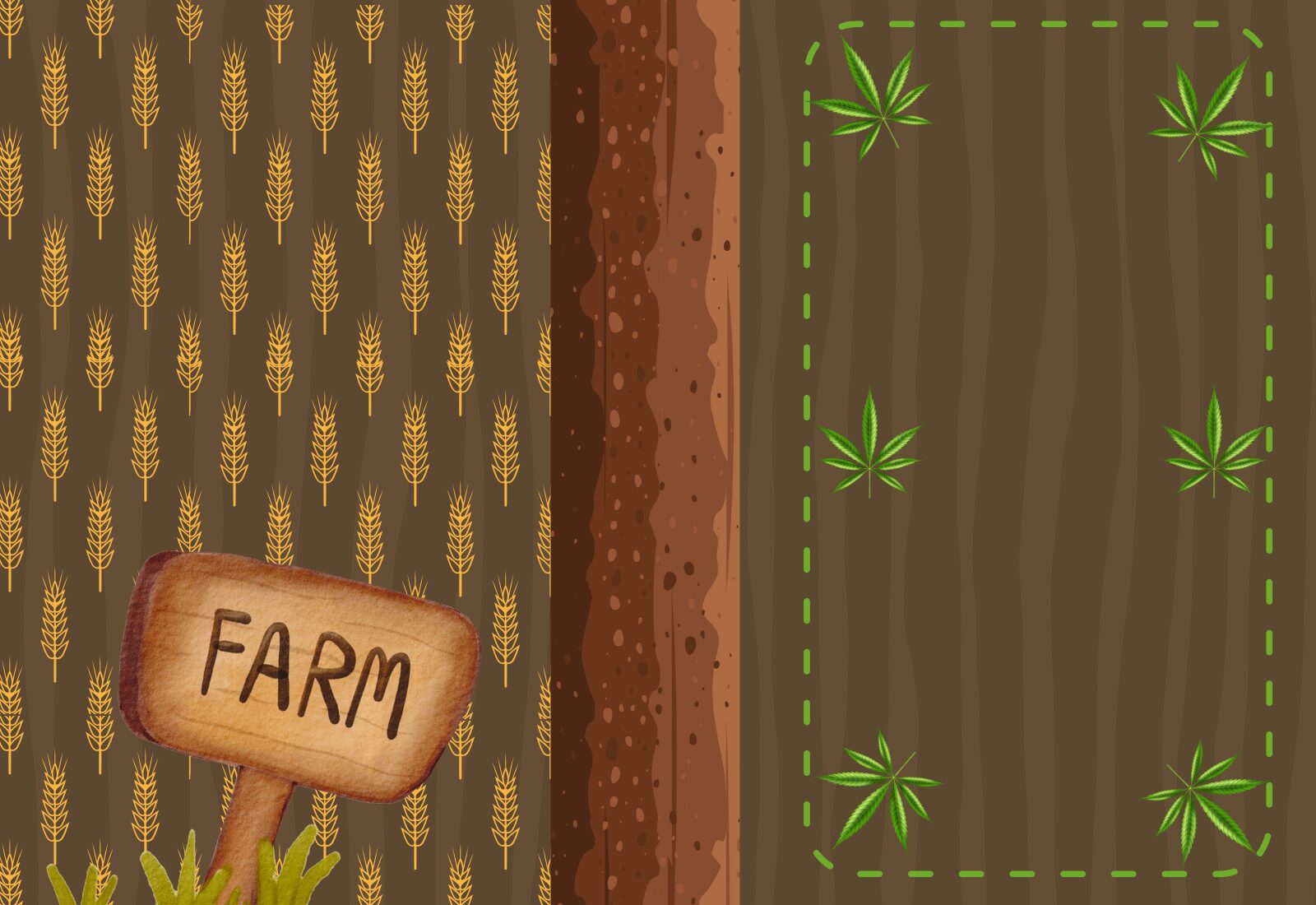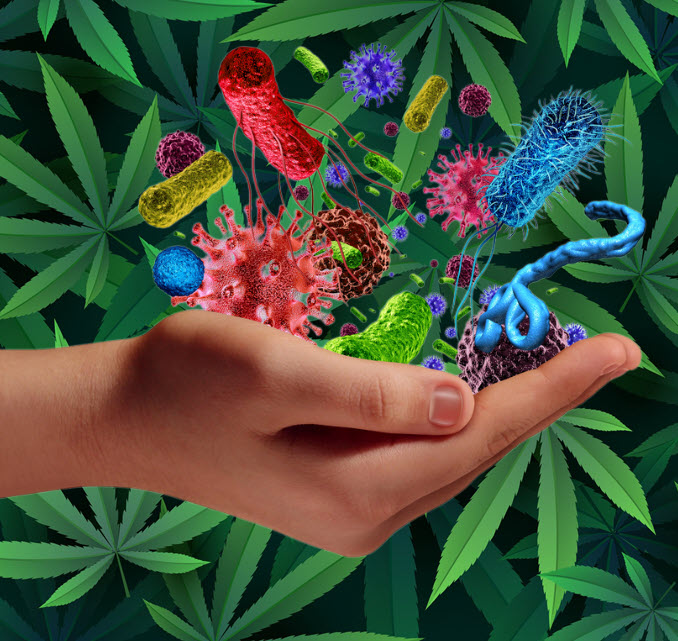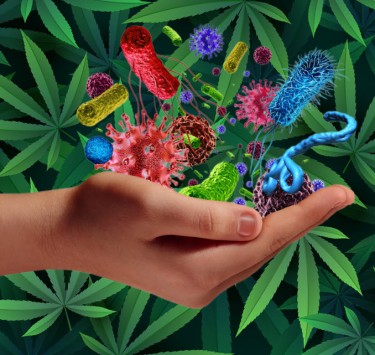Cannabis News
How to Control Humidity and Temperature in Your Indoor Grow Room » How to Grow Weed Indoors
Published
3 months agoon
By
admin
Creating the ideal environment in your indoor grow room is critical for the success of your plants, thus, knowing How to Control Humidity and Temperature in Your Indoor Grow Room is important.
Whether you are growing herbs, vegetables, or flowers, maintaining the right humidity and temperature is essential to maximize plant growth, health, and yield. This guide will explore the importance of controlling these environmental factors, provide actionable tips, and discuss the best tools and techniques to help you achieve optimal conditions in your indoor grow room.
Why Humidity and Temperature Control Matters
Maintaining the proper humidity and temperature in your indoor grow room is vital for several reasons. Plants are highly sensitive to environmental changes, and any fluctuations can affect their growth, health, and productivity.
Effects of Humidity on Plant Growth
Humidity levels influence a plant’s ability to absorb water and nutrients from the soil. When humidity is too high, plants may struggle to transpire, leading to nutrient deficiencies and mold growth. On the other hand, low humidity can cause plants to lose water too quickly, resulting in wilting and stunted growth.
Effects of Temperature on Plant Growth
Temperature affects a plant’s metabolic processes, including photosynthesis and respiration. If the temperature is too high, plants may overheat, leading to heat stress and potential damage to plant tissues. Conversely, low temperatures can slow down growth and, in extreme cases, cause frost damage.
Ideal Humidity and Temperature Levels
The ideal humidity and temperature levels for your indoor grow room depend on the type of plants you are cultivating. However, general guidelines can help you maintain a favorable environment for most plants.
- Humidity: For most plants, the ideal relative humidity (RH) ranges between 40% and 60%. Seedlings and young plants typically require higher humidity levels, around 60% to 70%, while mature plants thrive in lower humidity levels, between 40% and 50%.
-
Temperature: The optimal temperature for most indoor plants ranges between 70°F to 80°F (21°C to 27°C) during the day and 60°F to 70°F (16°C to 21°C) at night. Some plants may require slightly higher or lower temperatures, so it’s essential to know the specific needs of your plants.
Tools for Controlling Humidity and Temperature
To maintain optimal humidity and temperature levels, you’ll need to invest in the right tools and equipment. Here are some essential devices for controlling the environment in your indoor grow room:
1. Hygrometers and Thermometers
A hygrometer measures the humidity levels in your grow room, while a thermometer monitors the temperature. These tools are essential for keeping track of your grow room’s environment. Digital hygrometers and thermometers are recommended for their accuracy and ease of use. Some advanced models come with data logging capabilities, allowing you to track changes over time.
2. Humidifiers
If the humidity in your grow room is too low, a humidifier can help increase moisture levels. There are several types of humidifiers to choose from, including:
- Ultrasonic Humidifiers: These devices use ultrasonic vibrations to create a fine mist, increasing humidity without raising the temperature.
-
Evaporative Humidifiers: These work by blowing air over a wet wick or filter, which evaporates water into the air, raising humidity levels.
3. Dehumidifiers
If your grow room’s humidity is too high, a dehumidifier can help reduce excess moisture. Dehumidifiers work by drawing in humid air, cooling it to condense the moisture, and then reheating and releasing the dry air back into the room. This process helps maintain a stable humidity level, preventing issues like mold growth and nutrient deficiencies.
4. HVAC Systems
Heating, Ventilation, and Air Conditioning (HVAC) systems are crucial for controlling temperature and ensuring proper air circulation in your grow room. A well-designed HVAC system can regulate both temperature and humidity, providing a stable environment for your plants.
5. Air Conditioners and Heaters
Standalone air conditioners and heaters can be used to adjust the temperature in your grow room. Air conditioners are particularly useful in warm climates, while heaters are essential in colder environments. Some models come with built-in dehumidifiers, offering dual functionality.
6. Fans and Ventilation Systems
Proper air circulation is vital for preventing hot spots, distributing CO2, and maintaining even humidity levels throughout your grow room. Oscillating fans, exhaust fans, and intake fans can all play a role in ensuring your grow room has adequate airflow. Ventilation systems help exchange stale air with fresh air, reducing humidity and preventing the buildup of heat.
Step-by-Step Guide to Controlling Humidity and Temperature
Now that you understand the importance of humidity and temperature control and the tools available, let’s explore a step-by-step approach to achieving the ideal environment in your indoor grow room.
1. Assess Your Grow Room Environment
Before making any adjustments, assess the current conditions in your grow room. Use a hygrometer and thermometer to measure humidity and temperature levels. Take note of any fluctuations throughout the day and night.
2. Set Up Your Monitoring Equipment
Install digital hygrometers and thermometers at different locations within your grow room. This will help you monitor conditions in various areas and identify potential problem spots. If possible, choose devices with data logging features to track changes over time.
3. Adjust Humidity Levels
If your humidity levels are too low, set up a humidifier and adjust it to achieve the desired RH level. For high humidity, use a dehumidifier to remove excess moisture. It may take some time to find the right balance, so monitor the levels closely and make gradual adjustments.
4. Regulate Temperature
Depending on your grow room’s temperature, you may need to install an air conditioner, heater, or both. Set the devices to maintain the ideal temperature range for your plants. Remember that different stages of plant growth may require different temperature settings. For example, seedlings often need slightly warmer temperatures than mature plants.
5. Ensure Proper Air Circulation
Install fans and a ventilation system to promote air circulation. Oscillating fans can help distribute air evenly, preventing hot spots and ensuring that all plants receive fresh air. Exhaust fans and intake fans can be used to exchange indoor air with fresh outdoor air, helping to control both temperature and humidity.
6. Monitor and Adjust Regularly
Regularly check the humidity and temperature levels in your grow room and adjust your equipment as needed. Keep a log of any changes you make and observe how your plants respond. This will help you fine-tune your environment over time.
Advanced Tips for Optimal Humidity and Temperature Control
Once you have the basics down, consider these advanced tips to further optimize your grow room environment:
1. Use CO2 Enrichment
Carbon dioxide (CO2) is essential for photosynthesis and can enhance plant growth when provided in higher concentrations. CO2 generators or tanks can be used to enrich the air in your grow room, especially during the day when plants are actively photosynthesizing. However, higher CO2 levels may require slightly higher temperatures to maximize the benefits.
2. Implement a Climate Control System
Automated climate control systems can take the guesswork out of managing your grow room environment. These systems use sensors to monitor temperature, humidity, and CO2 levels and automatically adjust your equipment to maintain optimal conditions. While more expensive, climate control systems can save time and reduce the risk of human error.
3. Consider Light Intensity and Duration
The intensity and duration of light in your grow room can affect both temperature and humidity. High-intensity lights generate heat, which can raise the temperature. Ensure your lighting setup is appropriate for your grow room size and consider using LED lights, which produce less heat compared to traditional HPS or MH lights. Additionally, the photoperiod (light duration) should be adjusted according to the plant’s growth stage.
4. Use Insulation and Reflective Materials
Insulating your grow room and using reflective materials can help stabilize temperature and improve energy efficiency. Insulation prevents heat loss or gain through walls, floors, and ceilings, while reflective materials like Mylar reflect light and heat back into the room, reducing the need for additional heating or cooling.
Common Mistakes to Avoid
As you work to control humidity and temperature in your grow room, be mindful of common mistakes that can hinder your success:
- Neglecting Monitoring: Failing to regularly monitor humidity and temperature can lead to unnoticed fluctuations that stress your plants. Make it a habit to check your equipment daily.
-
Overcorrecting: Making large, sudden adjustments to humidity or temperature can shock your plants. Always make gradual changes and observe how your plants respond.
-
Ignoring Air Circulation: Poor air circulation can lead to uneven temperatures and humidity levels, creating microenvironments that are less than ideal for plant growth.
-
Using Inappropriate Equipment: Using equipment that is too small or too large for your grow room can lead to inefficiencies and difficulties in maintaining stable conditions. Choose equipment that matches the size and needs of your space.
Conclusion
Controlling humidity and temperature in your indoor grow room is crucial for achieving healthy, thriving plants. By understanding the effects of these environmental factors and utilizing the right tools and techniques, you can create the ideal growing conditions. Regular monitoring and adjustments, combined with advanced strategies like CO2 enrichment and climate control systems, will help you maintain a stable environment that promotes optimal plant growth and maximizes your yield.
Whether you are a novice grower or an experienced cultivator, following these guidelines will set you on the path to success in your indoor gardening endeavors.
Keywords
- Indoor grow room,
- Humidity control,
- Temperature control,
- Indoor gardening,
- Grow room environment,
- Climate control,
- Plant growth,
- Humidifier for grow room,
- Dehumidifier for grow room
- HVAC system for grow room
Please Share This Important Article
You may like
Cannabis News
California Appeals Court Rejects Marijuana Grow Permit, Citing Federal Illegality
Published
45 minutes agoon
November 22, 2024By
admin
In a landmark decision that highlights the tension between state and federal cannabis laws, a California appellate court ruled on October 29th that property owners can refuse to allow the transportation of cannabis across their land via easements, even when the cannabis operation is approved by local authorities.
The Second District Court of Appeal’s unanimous decision draws attention to private property rights in a context where cannabis remains federally illegal, but state law allows licensed cultivation, distribution and sale. Presiding Justice Albert Gilbert stated, “No matter how much California voters and the Legislature might try, cannabis cultivation and transportation are illegal in California as long as it remains illegal under federal law.” JCCrandall LLC v. County of Santa Barbara, Case No. B333201, 2024 WL 4599304, Oct. 29, 2024.
Unless the California Supreme Court grants review – which I would not rule out – the decision empowers private property owners to refuse to contract with cannabis businesses, and restricts local government from approving cannabis operations that implicate the property rights of neighbors who object.
The case at hand
The dispute centered around a cannabis cultivation operation in Santa Barbara County, where JCCrandall LLC challenged a conditional use permit granted by the County to its neighbor, Santa Rita Holdings Inc. The critical issue was that Santa Rita Holdings could only access its 2.5-acre cannabis farm via an unpaved road crossing JCCrandall’s property through a pre-existing easement. JCCrandall grows oats and barley.
JCCrandall’s primary concern? It raised a number of complaints with the Santa Barbara County Supervisors about truck traffic and night operations, which did not gain traction, but in the Court of Appeal JCCrandall focused on what it claimed was potential liability associated with having federally illegal substances transported across its property, even though County regulators found that the Santa Rita operation was fully compliant with state and local laws.
Key legal findings
The appellate court’s decision hinged on several crucial points:
- Property Rights: The court emphasized that “the right to exclude others is the essence of the right of property ownership” and classified it as a fundamental vested right.
- Federal Supremacy: The panel determined that allowing cannabis transportation across private property “defies the Supremacy Clause” of the U.S. Constitution.
- State vs. Federal Law: While cannabis might be legal under California law, the court ruled that federal law’s prohibition takes precedence in this context.
California cannabis industry implications
Legal experts suggest this ruling could have far-reaching consequences for California’s cannabis industry. Section 1550.5(b) of the California Civil Code makes contracts within California involving cannabis lawful and enforceable, and Santa Rita Holdings bet the ranch on that argument. But the Court of Appeal held that the statute could not compel a landowner to allow cannabis to travel across its property on a pre-existing easement. Licensed operators may find it harder to do business because neighbors who have property rights affected by a cannabis business can object, and, under the JCCrandall ruling, local government must yield to those objections.
An example might be a cannabis dispensary that depends on access to its parking lot via an easement or is located in a shopping center where other lessees have rights to object to tenants notwithstanding the approval of the landlord. In cultivation, many cannabis farms depend on vehicular access through easements because they are remote and do not always have direct access to public thoroughfares, or they depend on water sourced from other properties pursuant to agreements made by prior owners who grew traditional crops. These neighbors might not need to show any negative impact on their property, but can argue that they could be found complicit in federally illegal activities.
I think the most problematic language in the JCCrandall ruling is the following, which might draw the attention of the California Supreme Court and cause it to grant review: “For as long as an easement is enjoyed, its mode and manner of use shall remain substantially the same as it was at the time the easement was created. The County argues the easement was used for agricultural purposes. But there is a vast difference between legal and illegal agricultural purposes.” (Emphasis added.) If California has determined that cannabis cultivation is legal – as it has – and state courts routinely enforce contracts involving cannabis, it is a pretty bold step to declare the use of a lawful pre-existing easement illegal simply because the agricultural crop is cannabis and take away easement access from Santa Rita.
Looking ahead
This decision creates new challenges for cannabis businesses in California, and will result in more disputes among neighbors. While the Biden administration has shown signs of easing federal marijuana restrictions, this ruling demonstrates that the federal-state law conflict continues to create significant legal hurdles for the cannabis industry.
California court decisions also can be persuasive authority in other states, so we might see similar litigation (and decisions) elsewhere in the country where cannabis has been legalized.
The case serves as a reminder that despite California’s progressive stance on cannabis, federal prohibition continues to cast a long shadow over the industry’s operations and development. As the cannabis landscape continues to evolve, this ruling may prompt businesses to reassess their property arrangements and local governments will certainly have to reconsider their permitting processes to give more careful consideration to objections by neighbors who claim that their property rights are implicated by cannabis operations.
Note: This post was first published earlier this month on the Alger ADR Blog.
Cannabis News
Autoimmune Conditions Are Rising Fast in American Medicine, Can Cannabis Help?
Published
1 day agoon
November 21, 2024By
admin

Why Are Autoimmune Conditions On The Rise? And How Cannabis Can Help
Autoimmune diseases refer to a group of medical conditions that occur as a result of the immune system attacking your own tissues.
In a normal human body, the immune system is responsible for protecting the body by producing antibodies that prevent toxins, cancer cells, and viruses from harming the body. However, when one is struck by an autoimmune disorder, the immune system is no longer able to distinguish the difference between dangerous cells and healthy cells. As a result, the healthy cells are attacked, too.
Today, we know of around 100 different kinds of autoimmune conditions. Some of the most common examples of autoimmune conditions include rheumatoid arthritis (RA), lupus, inflammatory bowel disease, celiac disease, Type 1 diabetes, multiple sclerosis (MS), and the Guillain-Barre syndrome (GBS) to name a few. Others include Graves’ disease, Hashimoto’s thyroiditis, psoriasis, and vasculitis.
According to the National Health Council, around 50 million Americans are affected by autoimmune diseases today. This is a conservative estimate, considering that several autoimmune conditions are tricky to treat and so many people go undiagnosed for long periods of time. It’s worrisome to note that there are more people developing autoimmune diseases these days, many of which have reached levels comparable to epidemics.
But cannabis can help!
How Cannabis Can Help Curb And Manage Autoimmune Diseases
Not one single cause is responsible for the alarming growth of autoimmune diseases, though there are several factors at play. While there isn’t just one cause we can point at, it’s certain the reasons lie in our environment. After all, human genetics haven’t changed significantly yet the chemicals, toxins, and pollutants in our food and everyday items have risen dramatically.
In addition, people are getting less sleep than ever; stress rates are through the roof, and people are constantly worried. There is a clear link between psychological stress and physical health as well as immunity, which is why it isn’t unusual – it’s even common – to see many autoimmune disease cases flare up after people experience severe stress caused by grief, an accident, job loss, or the death of a loved one. These highly stressful and traumatic conditions wreak havoc on the body’s immune response, causing inflammation all over the body.
Conventional treatments prescribed to treat autoimmune conditions are focused on taming inflammation; these usually include steroids but also some non-steroidal drugs. These drugs often come with unwanted side effects, but research has shown that cannabis can work with the endocannabinoid system through THC and CBD, as well as other cannabinoids, to simulate similar results. In one study for example, we can see the clear association of the endocannabinoid system for neurodegenerative and inflammatory processes seen in Multiple Sclerosis and Amyotrophic Lateral Sclerosis.
There has also been an increasing number of studies proving the efficacy of cannabis for treating several autoimmune conditions.
Cannabis For Multiple Sclerosis
Multiple sclerosis is one of the autoimmune conditions where a growing number of studies have come out supporting the therapeutic benefits of cannabis for. In a 2024 study, patients with multiple sclerosis reported several improvements in quality of life after using cannabis-based medical products (CBMPs). For the study, British investigators analyzed the impact of cannabis based medicinal products made from either oil or extracts in 141 patients who were enrolled in the UK Medical Cannabis Registry.
The researchers then analyzed the changes in patient outcomes after a month, then three and 6 months after. According to the patients themselves, they were able to sustain improvements in their mental and physical health after marijuana therapy.
“This case series demonstrates a potential association between the initiation of CBMPs and improved patient reported outcomes in sleep, anxiety, and general HRQoL [health-related quality of life] measures, over six months,” said the study authors. “Additional measures for HRQoL, including various physical and mental health subdomains, also exhibit improvements up to six months when compared to baseline,” the authors concluded.
In another study from 2023, patients with multiple sclerosis reported significant improvements in symptoms after cannabis use. For the study, researchers from the Dent Neurologic Institute in Buffalo, New York, analyzed the medical records of 141 patients with multiple sclerosis, who were also legally authorized to consume medical marijuana products. They then analyzed data from the patients after one up to 4 follow-up sessions after the initial session of cannabis therapy. Sixty-five percent of patients consumed 1:1 THC:CBD tinctures.
According to the authors: “The results of this study indicate that use of MC [medical cannabis] to alleviate symptoms of MS is largely efficacious, with improvement in pain (72 percent of patients), muscle spasticity (48 percent of patients), and sleep disturbance (40 percent of patients) frequently reported.”
“More than half of opioid users at baseline were able to either discontinue or decrease their opioid use after starting MC. The mean daily MME [morphine milligram equivalents] was significantly reduced from the initial visit (51 mg) to the last follow-up visit (40 mg). This is consistent with previous literature showing that MC legalization is associated with decreased opioid use and that MC use is associated with decreased opioid use in patients with chronic pain. These findings indicate that MC may represent an alternative analgesic to opioids for some patients,” they wrote.
Anecdotal Evidence
While more studies are needed to determine cannabis’ effect on other autoimmune conditions such as rheumatoid arthritis, we can rely on anecdotal evidence. In 2020, data from the medical journal, Rheumatology, revealed that patients who have this condition, along with those who have lupus and fibromyalgia, consume cannabis.
In fact, it was reported that marijuana was extremely common especially for patients with fibromyalgia. “In this meta-analysis, we found that one in six patients suffering from rheumatologic disease actively consumes cannabis, reducing pain reduction… A favorable effect of cannabis on pain in our meta-analysis reinforces the idea that cannabis could be used for analgesic purposes,” the authors concluded.
Conclusion
Cannabis is a safe and natural way to help prevent and treat the symptoms of autoimmune disease. It targets inflammation at its root, and is a proven natural way to help cope with stress, pain, insomnia, and inflammation all while protecting the brain. However, it’s important to ensure you medicate with clean, organic sources of marijuana.
AUTOIMMUNE AND CANNABIS, READ ON…

The U.S. Senate’s version of the Farm Bill finally landed this week. They’re calling it the Rural Prosperity and Food Security Act of 2024 (the “Senate bill”). The Senate bill follows on the House’s proposal, called the Farm, Food and National Security Act of 2024 (the “House bill”), offered in May. Neither the Senate bill nor the House bill would preempt state or Indian law regarding hemp or the regulation of hemp products. This means states and tribes will retain a lot of latitude in regulating hemp and hemp-derived products– which gets people fired up.
Aside from giving states some runway, the Senate bill and the House bill differ in key respects regarding hemp. Therefore, these august bodies must confer and reconcile their sundry proposals. That could happen in 2024, but seems more likely in 2025 when the new Congress convenes. As of this week, though, we finally have a framework.
The Senate Bill re-defines “hemp” and defines “industrial hemp”
Section 10016 of the Senate bill (“Hemp Production”) amends the definition of “hemp.” Hemp was defined in the 2018 Farm Bill and removed from the federal Controlled Substances Act (CSA), taking us on a truly wild ride. See: What Happened to Hemp? (“What Happened”). The Senate bill also gives us a definition for “industrial hemp.” Here are those definitions, with points of emphasis in bold:
(1) Hemp. The term “hemp” means (A) the plant Cannabis sativa L. and any part of that plant, including the seeds thereof and all derivatives, extracts, cannabinoids, isomers, acids, salts, and salts of isomers, whether growing or not, with a delta-9 total tetrahydrocannabinol concentration (including tetrahydrocannabinolic acid) of not more than 0.3 percent on a dry weight basis; and (B) industrial hemp.
(3) Industrial Hemp. The term “industrial hemp” means the plant Cannabis sativa L. if the harvested material (A) is only (i) the stalks of that plant, fiber produced from those stalks, or any other manufactured product, derivative, mixture, or preparation of those stalks (except cannabinoid resin extracted from those stalks); (ii) whole grain, oil, cake, nut, hull, or any other compound, manufactured product, derivative, mixture, or preparation of the seeds of that plant (except cannabinoid resin extracted from the seeds of that plant); or (iii) viable seeds of that plant produced solely for production or manufacture of any material described in clause (i) or (ii); and (B) will not be used in the manufacturing or synthesis of natural or synthetic cannabinoid products.
The new regime
Again, the definitional stuff in bold is what I want to emphasize.
First, the Senate bill keeps the THC threshold at 0.3 percent, which is an arbitrary number we’ve been advocating against for years. The Senate bill mirrors the House bill in this respect, though, so we are stuck with this, unless Ron Paul gets his way.
Second, the Senate bill keeps the 2018 Farm Bill’s total THC standard, including THCA. The House bill does this too. This was fairly predictable: in What Happened, I wrote that we could “expect the total THC standard to remain, which means that actual Delta-9 THC won’t be the only metric for calculating THC content.”
We’ve also explained on this blog that the 2018 Farm Bill and USDA rules mandate total THC testing on pre-harvest hemp batches, but do not mandate such testing on post-harvest hemp or hemp products. The Senate bill doesn’t change this paradigm, which means the “loophole” for gas station weed remains open. This proposal is a big win for opponents of the House bill’s “Miller Amendment,” which would narrow the definition of “hemp” to exclude intoxicating hemp-derived substances.
Third, the Senate bill introduces a new definition and framework for industrial hemp. The House bill does this too, albeit slightly differently. The idea here is to invite farmers to grow hemp for fiber and grain purposes, while freeing them from regulatory burdens with the Department of Agriculture and criminal exposure with the Department of Justice. More specifically, for “industrial hemp” growers, the Senate bill:
- removes background check requirements;
- instates “relaxed regulatory requirements” for sampling and inspection methodologies (which will need to be adopted by rule); and
- develops a certified seed program.
The Senate bill also makes any hemp producer ineligible to grow hemp for five years if that producer, “with a culpable mental state greater than negligence, produces a crop of hemp that is inconsistent with that license.”(Hint: use the seed program.) The proof standard here seems like it could be an issue, and even if anyone has been adjudicated as growing marijuana under the guise of hemp, Farm Bill ineligibility seems like a far-off concern.
Bottom line
The big takeaway for me is that the Senate bill leaves the door open for intoxicating hemp products, whereas the Miller Amendment to the House bill does not. Something’s gotta give. And it needs to happen soon, because we’re already long overdue. As I explained in a webinar last week, the Farm Bill deals with the nation’s entire food supply, not just hemp. Therefore, this is not like with the SAFE Banking Act, where we have a proposed law specific to cannabis that may or may not ever pass. The Farm Bill must pass, and soon.
Stay tuned and we’ll keep you updated on any major happenings. For more on this topic, check out our massive hemp and CBD archive, or these specific, recent posts:

California Appeals Court Rejects Marijuana Grow Permit, Citing Federal Illegality

Expert Lighting Tips For Successful Indoor Growing Weed

Acne And CBD: Exploring Alternative Dermatological Solutions

Can I Gift Marijuana This Holiday Season?

The Best Cocktails For An Easy Festive Thanksgiving

420 Vacations: Planning the Perfect Weed Vacation

Can Microdosing Help Manage Holiday Family Anxiety

11 Weed Shows and Movies on Netflix Worth Watching

Lawsuit Says DEA Acting In Bad Faith Over Marijuana

Autoimmune Conditions Are Rising Fast in American Medicine, Can Cannabis Help?

Distressed Cannabis Business Takeaways – Canna Law Blog™

United States: Alex Malyshev And Melinda Fellner Discuss The Intersection Of Tax And Cannabis In New Video Series – Part VI: Licensing (Video)

What you Need to Know

Drug Testing for Marijuana – The Joint Blog

NCIA Write About Their Equity Scholarship Program

It has been a wild news week – here’s how CBD and weed can help you relax

Cannabis, alcohol firm SNDL loses CA$372.4 million in 2022

A new April 20 cannabis contest includes a $40,000 purse

Your Go-To Source for Cannabis Logos and Designs

UArizona launches online cannabis compliance online course
Trending
-

 Cannabis News2 years ago
Cannabis News2 years agoDistressed Cannabis Business Takeaways – Canna Law Blog™
-

 One-Hit Wonders2 years ago
One-Hit Wonders2 years agoUnited States: Alex Malyshev And Melinda Fellner Discuss The Intersection Of Tax And Cannabis In New Video Series – Part VI: Licensing (Video)
-

 Cannabis 1012 years ago
Cannabis 1012 years agoWhat you Need to Know
-

 drug testing11 months ago
drug testing11 months agoDrug Testing for Marijuana – The Joint Blog
-

 Education2 years ago
Education2 years agoNCIA Write About Their Equity Scholarship Program
-

 Cannabis2 years ago
Cannabis2 years agoIt has been a wild news week – here’s how CBD and weed can help you relax
-

 Marijuana Business Daily2 years ago
Marijuana Business Daily2 years agoCannabis, alcohol firm SNDL loses CA$372.4 million in 2022
-

 California2 years ago
California2 years agoA new April 20 cannabis contest includes a $40,000 purse





